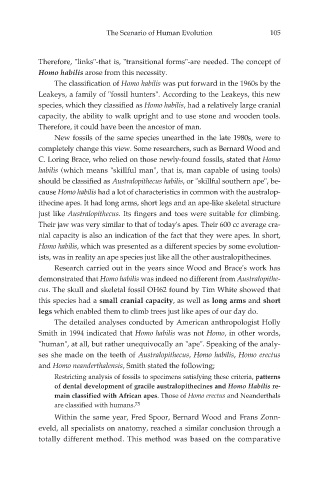Page 107 - The Evolution Deceit
P. 107
The Sce nar io of Hu man Ev o lu tion 105
Therefore, "links"-that is, "transitional forms"-are needed. The concept of
Homo habilis arose from this necessity.
The classification of Homo habilis was put forward in the 1960s by the
Leakeys, a family of "fossil hunters". According to the Leakeys, this new
species, which they classified as Homo habilis, had a relatively large cranial
capacity, the ability to walk upright and to use stone and wooden tools.
Therefore, it could have been the ancestor of man.
New fossils of the same species unearthed in the late 1980s, were to
completely change this view. Some researchers, such as Bernard Wood and
C. Loring Brace, who relied on those newly-found fossils, stated that Homo
habilis (which means "skillful man", that is, man capable of using tools)
should be classified as Australopithecus habilis, or "skillful southern ape", be-
cause Homo habilis had a lot of characteristics in common with the australop-
ithecine apes. It had long arms, short legs and an ape-like skeletal structure
just like Australopithecus. Its fingers and toes were suitable for climbing.
Their jaw was very similar to that of today's apes. Their 600 cc average cra-
nial capacity is also an indication of the fact that they were apes. In short,
Homo habilis, which was presented as a different species by some evolution-
ists, was in reality an ape species just like all the other australopithecines.
Research carried out in the years since Wood and Brace's work has
demonstrated that Homo habilis was indeed no different from Australopithe-
cus. The skull and skeletal fossil OH62 found by Tim White showed that
this species had a small cranial capacity, as well as long arms and short
legs which enabled them to climb trees just like apes of our day do.
The detailed analyses conducted by American anthropologist Holly
Smith in 1994 indicated that Homo habilis was not Homo, in other words,
"human", at all, but rather unequivocally an "ape". Speaking of the analy-
ses she made on the teeth of Australopithecus, Homo habilis, Homo erectus
and Homo neanderthalensis, Smith stated the following;
Restricting analysis of fossils to specimens satisfying these criteria, patterns
of dental development of gracile australopithecines and Homo Habilis re-
main classified with African apes. Those of Homo erectus and Neanderthals
are classified with humans. 75
Within the same year, Fred Spoor, Bernard Wood and Frans Zonn-
eveld, all specialists on anatomy, reached a similar conclusion through a
totally different method. This method was based on the comparative

